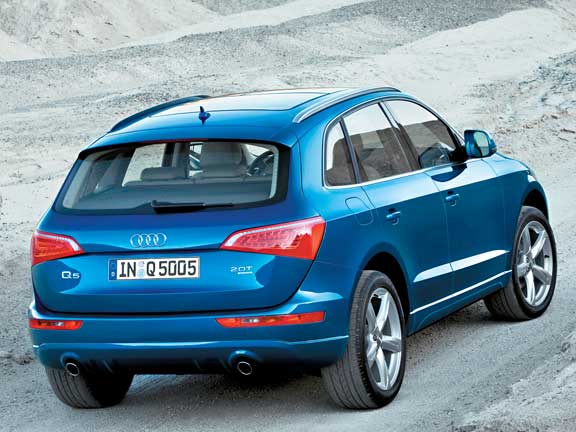
Audi is pushing the sports car angle with its new Q5 compact SUV announced in Europe this week. The Q5 will arrive here early next year. Audi says the vehicle combines “the dynamism of a sports sedan with highly variable interior and versatile options for leisure-time and family use.” It has, quattro permanent all-wheel drive, a seven-speed S tronic dual-clutch transmission and the Audi drive select control system. The car is 4.63 metres long and 1.88 metres wide, and at 1.65 metres high has a low profile for a SUV. Audi aerodynamicists have achieved a low drag coefficient of 0.33. The car’s front end is dominated by expressive headlights on both sides of the large single-frame grille. As an option the lights can be outfitted with bi-xenon lamps and LED daytime running lights.
The wraparound tailgate – made from aluminum just like the bonnet – gives the Q5 a family link to its older and bigger brother, the Q7. The 2.81-metre wheelbase creates a roomy interior which will accommodate five people in ergonomically designed seats that can be flexibly arranged. Interior trim accents include aluminium, exclusive woods, chrome, leather and Alcantara as well as a large selection of optional design packages. The Audi Q5 comes standard with an electromechanical parking brake, an intelligent chip key, a climate control air-conditioning system and a display screen in the instrument cluster depicting, among other things, the recommended ideal gear for efficient driving in any given situation.
In Europe Audi is offering the Q5 with three engine variants – one petrol and two turbodiesels. The 2.0 TFSI is a four-cylinder with turbocharging, petrol direct-injection and the Audi valvelift system for variable control of valve lift. Peak torque of 350Nm is available at 1500rpm and remains constant up to 4200rpm. Maximum power is 155kW and the Audi Q5 2.0 TFSI sprints from 0 to 100kph in 7.2 seconds. Top speed is 222kph. Audi says the petrol Q5 is capable of achieving fuel consumption of 8.5 litres/100km.
The 2.0 TDI turbodiesel motor delivers 350Nm of torque between 1750 and 2500rpm, and maximum power of 125kW. Audi says average fuel consumption is 6.7 litres/100km and the car will hit 100kph in 9.5 seconds, and reach a top speed of 204km/h.
The most powerful engine in the line-up is the 3.0 TDI V6 diesel. Maximum power is 176kW, with 500Nm of torque available between 1500 and 3000rpm; 0 to 100kph takes 6.5 seconds, top speed is 225km/h, and ASudi says the V6 diesel can deliver fuel economy of seven litres/100skm. The 2.0 TDI runs a six-speed manual transmission, but the other models use the S tronic twin-clutch seven speeder.
It can shift gears in a fraction of a second, and drivers can let the seven-speed S tronic shift automatically or select gears manually, using switches on the steering wheel. The car’s differential is located in front of the clutch, directly behind the engine. That made it possible to move the front axle much further forward, creating a long wheelbase and optimum distribution of axle load. In normal running conditions, the transfer case distributes the power to the front and rear axle in a 40:60 ratio. When needed, the quattro driveline can deliver up to 65 per cent of the power to the front axle and a maximum of 85 per cent to the rear axle. The Q5’s electronic stabilisation programme (ESP) has been re-designed and enhanced. A sensor “tells” the ESP if a roof rack has been mounted, causing the Audi Q5’s centre of gravity to be shifted higher in keeping with a roof load of up to 100kg. If a roof rack is present, the ESP engages earlier. The Q5 can tow up to two tonnes, and has standard hill descent control system which operates under 30kph. It can climb a 31-degree incline, has 200mm of ground clearance, and can ford water up to 500mm deep. The Q5’s Audi drive select systems has an electronic controller for the shock absorbers, and a dynamic steering feature which continuously varies the steering ratio and the power steering assistance depending on vehicle speed. At the limit of adhesion, the dynamic steering, in conjunction with the ESP, stabilises the Q5 by making instantaneous steering interventions.
Standard and optional equipment includes a Bluetooth telephone, a DVD drive, a TV tuner, an intelligent speech control system, an iPod interface and a top-of-the-line sound system from the Danish specialists Bang and Olufsen. Optional equipment also includes the Audi parking system with rearview camera, and Audi side assist, which warns of hazards when changing lanes. Additional high-tech extras for the Audi Q5 include the advanced key for keyless access to the vehicle, a tyre pressure monitoring system, the large panoramic glass sunroof with additional tilting function, the triple-zone climate control system, sun blinds for the rear side windows, the dynamic cornering light system known as Audi adaptive light, an electric tailgate and a swiveling trailer hitch. New Zealand pricing and specifications are yet to be finalised.